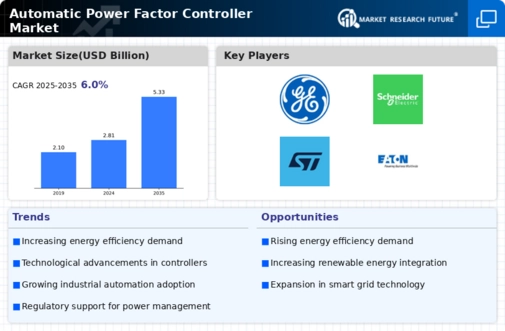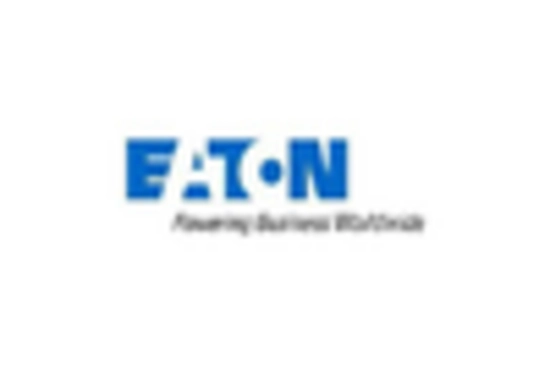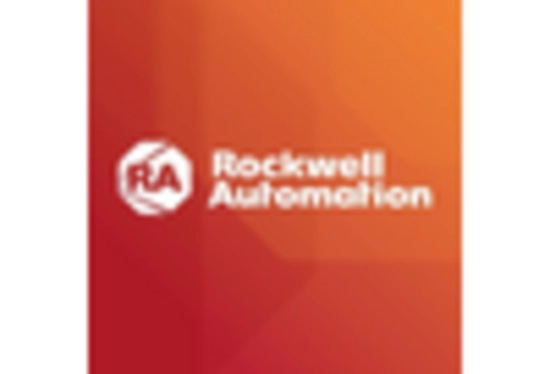-
EXECUTIVE SUMMARY
-
MARKET INTRODUCTION
-
Definition
-
Scope of the Study
- Research Objective
- Assumptions
- Limitations
-
RESEARCH METHODOLOGY
-
Overview
-
Data Mining
-
Secondary Research
-
Primary Research
- Primary Interviews and Information Gathering Process
- Breakdown of Primary Respondents
-
Forecasting Model
-
Market Size Estimation
- Bottom-Up Approach
- Top-Down Approach
-
Data Triangulation
-
Validation
-
MARKET DYNAMICS
-
Overview
-
Drivers
-
Restraints
-
Opportunities
-
MARKET FACTOR ANALYSIS
-
Value Chain Analysis
-
Porter’s Five Forces Analysis
- Bargaining Power of Suppliers
- Bargaining Power of Buyers
- Threat of New Entrants
- Threat of Substitutes
- Intensity of Rivalry
-
COVID-19 Impact Analysis
- Market Impact Analysis
- Regional Impact
- Opportunity and Threat Analysis
-
GLOBAL AUTOMATIC POWER FACTOR CONTROLLER MARKET, BY TYPE
-
Overview
-
Passive APFCs
-
Active APFCs
-
GLOBAL AUTOMATIC POWER FACTOR CONTROLLER MARKET, BY COMPONENT
-
Overview
-
Relays
-
Capacitors
-
Registers
-
Displays
-
Microcontrollers
-
Switches
-
GLOBAL AUTOMATIC POWER FACTOR CONTROLLER MARKET, BY INSTALLATION TYPE
-
Overview
-
Self-Standing APFC Panels
-
Wall-Mounted APFC Panels
-
GLOBAL AUTOMATIC POWER FACTOR CONTROLLER MARKET, BY REGION
-
Overview
-
North America
- US
- Canada
-
Europe
- Germany
- France
- UK
- Italy
- Spain
- Rest of Europe
-
Asia-Pacific
- China
- India
- Japan
- South Korea
- Australia
- Rest of Asia-Pacific
-
Rest of the World
- Middle East
- Africa
- Latin America
-
COMPETITIVE LANDSCAPE
-
Overview
-
Competitive Analysis
-
Market Share Analysis
-
Major Growth Strategy in the Global Automatic Power Factor Controller Market,
-
Competitive Benchmarking
-
Leading Players in Terms of Number of Developments in the Global Automatic Power Factor Controller Market,
-
Key developments and Growth Strategies
- New Product Launch/Service Deployment
- Merger & Acquisitions
- Joint Ventures
-
Major Players Financial Matrix
- Sales & Operating Income, 2025
- Major Players R&D Expenditure. 2025
-
COMPANY PROFILES
-
General Electric
- Company Overview
- Financial Overview
- Products Offered
- Key Developments
- SWOT Analysis
- Key Strategies
-
Siemens AG
- Company Overview
- Financial Overview
- Products Offered
- Key Developments
- SWOT Analysis
- Key Strategies
-
ABB
- Company Overview
- Financial Overview
- Products Offered
- Key Developments
- SWOT Analysis
- Key Strategies
-
Emerson Electric Co.
- Company Overview
- Financial Overview
- Products Offered
- Key Developments
- SWOT Analysis
- Key Strategies
-
AVEVA Group plc
- Company Overview
- Financial Overview
- Products Offered
- Key Developments
- SWOT Analysis
- Key Strategies
-
Schneider Electric
- Company Overview
- Financial Overview
- Products Offered
- Key Developments
- SWOT Analysis
- Key Strategies
-
STMicroelectronics
- Company Overview
- Financial Overview
- Products Offered
- Key Developments
- SWOT Analysis
- Key Strategies
-
AB POWER SYSTEMS
- Company Overview
- Financial Overview
- Products Offered
- Key Developments
- SWOT Analysis
- Key Strategies
-
Eaton
- Company Overview
- Financial Overview
- Products Offered
- Key Developments
- SWOT Analysis
- Key Strategies
-
Fujitsu
- Company Overview
- Financial Overview
- Products Offered
- Key Developments
- SWOT Analysis
- Key Strategies
-
APPENDIX
-
References
-
Related Reports
-
-
LIST OF TABLES
-
GLOBAL AUTOMATIC POWER FACTOR CONTROLLER MARKET, SYNOPSIS, 2025-2034
-
GLOBAL AUTOMATIC POWER FACTOR CONTROLLER MARKET, ESTIMATES & FORECAST, 2025-2034 (USD BILLION)
-
GLOBAL AUTOMATIC POWER FACTOR CONTROLLER MARKET, BY TYPE, 2025-2034 (USD BILLION)
-
GLOBAL AUTOMATIC POWER FACTOR CONTROLLER MARKET, BY COMPONENT, 2025-2034 (USD BILLION)
-
GLOBAL AUTOMATIC POWER FACTOR CONTROLLER MARKET, BY INSTALLATION TYPE, 2025-2034 (USD BILLION)
-
NORTH AMERICA: AUTOMATIC POWER FACTOR CONTROLLER MARKET, BY TYPE, 2025-2034 (USD BILLION)
-
NORTH AMERICA: AUTOMATIC POWER FACTOR CONTROLLER MARKET, BY COMPONENT, 2025-2034 (USD BILLION)
-
NORTH AMERICA: AUTOMATIC POWER FACTOR CONTROLLER MARKET, BY INSTALLATION TYPE, 2025-2034 (USD BILLION)
-
US: AUTOMATIC POWER FACTOR CONTROLLER MARKET, BY TYPE, 2025-2034 (USD BILLION)
-
US: AUTOMATIC POWER FACTOR CONTROLLER MARKET, BY COMPONENT, 2025-2034 (USD BILLION)
-
US: AUTOMATIC POWER FACTOR CONTROLLER MARKET, BY INSTALLATION TYPE, 2025-2034 (USD BILLION)
-
CANADA: AUTOMATIC POWER FACTOR CONTROLLER MARKET, BY TYPE, 2025-2034 (USD BILLION)
-
CANADA: AUTOMATIC POWER FACTOR CONTROLLER MARKET, BY COMPONENT, 2025-2034 (USD BILLION)
-
CANADA: AUTOMATIC POWER FACTOR CONTROLLER MARKET, BY INSTALLATION TYPE, 2025-2034 (USD BILLION)
-
EUROPE: AUTOMATIC POWER FACTOR CONTROLLER MARKET, BY TYPE, 2025-2034 (USD BILLION)
-
EUROPE: AUTOMATIC POWER FACTOR CONTROLLER MARKET, BY COMPONENT, 2025-2034 (USD BILLION)
-
EUROPE: AUTOMATIC POWER FACTOR CONTROLLER MARKET, BY INSTALLATION TYPE, 2025-2034 (USD BILLION)
-
GERMANY: AUTOMATIC POWER FACTOR CONTROLLER MARKET, BY TYPE, 2025-2034 (USD BILLION)
-
GERMANY: AUTOMATIC POWER FACTOR CONTROLLER MARKET, BY COMPONENT, 2025-2034 (USD BILLION)
-
GERMANY: AUTOMATIC POWER FACTOR CONTROLLER MARKET, BY INSTALLATION TYPE, 2025-2034 (USD BILLION)
-
FRANCE: AUTOMATIC POWER FACTOR CONTROLLER MARKET, BY TYPE, 2025-2034 (USD BILLION)
-
FRANCE: AUTOMATIC POWER FACTOR CONTROLLER MARKET, BY COMPONENT, 2025-2034 (USD BILLION)
-
FRANCE: AUTOMATIC POWER FACTOR CONTROLLER MARKET, BY INSTALLATION TYPE, 2025-2034 (USD BILLION)
-
ITALY: AUTOMATIC POWER FACTOR CONTROLLER MARKET, BY TYPE, 2025-2034 (USD BILLION)
-
ITALY: AUTOMATIC POWER FACTOR CONTROLLER MARKET, BY COMPONENT, 2025-2034 (USD BILLION)
-
ITALY: AUTOMATIC POWER FACTOR CONTROLLER MARKET, BY INSTALLATION TYPE, 2025-2034 (USD BILLION)
-
SPAIN: AUTOMATIC POWER FACTOR CONTROLLER MARKET, BY TYPE, 2025-2034 (USD BILLION)
-
SPAIN: AUTOMATIC POWER FACTOR CONTROLLER MARKET, BY COMPONENT, 2025-2034 (USD BILLION)
-
SPAIN: AUTOMATIC POWER FACTOR CONTROLLER MARKET, BY INSTALLATION TYPE, 2025-2034 (USD BILLION)
-
UK: AUTOMATIC POWER FACTOR CONTROLLER MARKET, BY TYPE, 2025-2034 (USD BILLION)
-
UK: AUTOMATIC POWER FACTOR CONTROLLER MARKET, BY COMPONENT, 2025-2034 (USD BILLION)
-
UK: AUTOMATIC POWER FACTOR CONTROLLER MARKET, BY INSTALLATION TYPE, 2025-2034 (USD BILLION)
-
REST OF EUROPE: AUTOMATIC POWER FACTOR CONTROLLER MARKET, BY TYPE, 2025-2034 (USD BILLION)
-
REST OF EUROPE: AUTOMATIC POWER FACTOR CONTROLLER MARKET, BY COMPONENT, 2025-2034 (USD BILLION)
-
REST OF EUROPE: AUTOMATIC POWER FACTOR CONTROLLER MARKET, BY INSTALLATION TYPE, 2025-2034 (USD BILLION)
-
ASIA-PACIFIC: AUTOMATIC POWER FACTOR CONTROLLER MARKET, BY TYPE, 2025-2034 (USD BILLION)
-
ASIA-PACIFIC: AUTOMATIC POWER FACTOR CONTROLLER MARKET, BY COMPONENT, 2025-2034 (USD BILLION)
-
ASIA-PACIFIC: AUTOMATIC POWER FACTOR CONTROLLER MARKET, BY INSTALLATION TYPE, 2025-2034 (USD BILLION)
-
JAPAN: AUTOMATIC POWER FACTOR CONTROLLER MARKET, BY TYPE, 2025-2034 (USD BILLION)
-
JAPAN: AUTOMATIC POWER FACTOR CONTROLLER MARKET, BY COMPONENT, 2025-2034 (USD BILLION)
-
JAPAN: AUTOMATIC POWER FACTOR CONTROLLER MARKET, BY INSTALLATION TYPE, 2025-2034 (USD BILLION)
-
CHINA: AUTOMATIC POWER FACTOR CONTROLLER MARKET, BY TYPE, 2025-2034 (USD BILLION)
-
CHINA: AUTOMATIC POWER FACTOR CONTROLLER MARKET, BY COMPONENT, 2025-2034 (USD BILLION)
-
CHINA: AUTOMATIC POWER FACTOR CONTROLLER MARKET, BY INSTALLATION TYPE, 2025-2034 (USD BILLION)
-
INDIA: AUTOMATIC POWER FACTOR CONTROLLER MARKET, BY TYPE, 2025-2034 (USD BILLION)
-
INDIA: AUTOMATIC POWER FACTOR CONTROLLER MARKET, BY COMPONENT, 2025-2034 (USD BILLION)
-
INDIA: AUTOMATIC POWER FACTOR CONTROLLER MARKET, BY INSTALLATION TYPE, 2025-2034 (USD BILLION)
-
AUSTRALIA: AUTOMATIC POWER FACTOR CONTROLLER MARKET, BY TYPE, 2025-2034 (USD BILLION)
-
AUSTRALIA: AUTOMATIC POWER FACTOR CONTROLLER MARKET, BY COMPONENT, 2025-2034 (USD BILLION)
-
AUSTRALIA: AUTOMATIC POWER FACTOR CONTROLLER MARKET, BY INSTALLATION TYPE, 2025-2034 (USD BILLION)
-
SOUTH KOREA: AUTOMATIC POWER FACTOR CONTROLLER MARKET, BY TYPE, 2025-2034 (USD BILLION)
-
SOUTH KOREA: AUTOMATIC POWER FACTOR CONTROLLER MARKET, BY COMPONENT, 2025-2034 (USD BILLION)
-
SOUTH KOREA: AUTOMATIC POWER FACTOR CONTROLLER MARKET, BY INSTALLATION TYPE, 2025-2034 (USD BILLION)
-
REST OF ASIA-PACIFIC: AUTOMATIC POWER FACTOR CONTROLLER MARKET, BY TYPE, 2025-2034 (USD BILLION)
-
REST OF ASIA-PACIFIC: AUTOMATIC POWER FACTOR CONTROLLER MARKET, BY COMPONENT, 2025-2034 (USD BILLION)
-
REST OF ASIA-PACIFIC: AUTOMATIC POWER FACTOR CONTROLLER MARKET, BY INSTALLATION TYPE, 2025-2034 (USD BILLION)
-
REST OF THE WORLD: AUTOMATIC POWER FACTOR CONTROLLER MARKET, BY TYPE, 2025-2034 (USD BILLION)
-
REST OF THE WORLD: AUTOMATIC POWER FACTOR CONTROLLER MARKET, BY COMPONENT, 2025-2034 (USD BILLION)
-
REST OF THE WORLD: AUTOMATIC POWER FACTOR CONTROLLER MARKET, BY INSTALLATION TYPE, 2025-2034 (USD BILLION)
-
MIDDLE EAST: AUTOMATIC POWER FACTOR CONTROLLER MARKET, BY TYPE, 2025-2034 (USD BILLION)
-
MIDDLE EAST: AUTOMATIC POWER FACTOR CONTROLLER MARKET, BY COMPONENT, 2025-2034 (USD BILLION)
-
MIDDLE EAST: AUTOMATIC POWER FACTOR CONTROLLER MARKET, BY INSTALLATION TYPE, 2025-2034 (USD BILLION)
-
AFRICA: AUTOMATIC POWER FACTOR CONTROLLER MARKET, BY TYPE, 2025-2034 (USD BILLION)
-
AFRICA: AUTOMATIC POWER FACTOR CONTROLLER MARKET, BY COMPONENT, 2025-2034 (USD BILLION)
-
AFRICA: AUTOMATIC POWER FACTOR CONTROLLER MARKET, BY INSTALLATION TYPE, 2025-2034 (USD BILLION)
-
LATIN AMERICA: AUTOMATIC POWER FACTOR CONTROLLER MARKET, BY TYPE, 2025-2034 (USD BILLION)
-
LATIN AMERICA: AUTOMATIC POWER FACTOR CONTROLLER MARKET, BY COMPONENT, 2025-2034 (USD BILLION)
-
LATIN AMERICA: AUTOMATIC POWER FACTOR CONTROLLER MARKET, BY INSTALLATION TYPE, 2025-2034 (USD BILLION)
-
LIST OF FIGURES
-
RESEARCH PROCESS
-
MARKET STRUCTURE FOR THE GLOBAL AUTOMATIC POWER FACTOR CONTROLLER MARKET
-
MARKET DYNAMICS FOR THE GLOBAL AUTOMATIC POWER FACTOR CONTROLLER MARKET
-
GLOBAL AUTOMATIC POWER FACTOR CONTROLLER MARKET, SHARE (%), BY TYPE, 2025
-
GLOBAL AUTOMATIC POWER FACTOR CONTROLLER MARKET, SHARE (%), BY COMPONENT, 2025
-
GLOBAL AUTOMATIC POWER FACTOR CONTROLLER MARKET, SHARE (%), BY INSTALLATION TYPE, 2025
-
GLOBAL AUTOMATIC POWER FACTOR CONTROLLER MARKET, SHARE (%), BY INSTALLATION TYPE, 2025
-
GLOBAL AUTOMATIC POWER FACTOR CONTROLLER MARKET, SHARE (%), BY REGION, 2025
-
NORTH AMERICA: AUTOMATIC POWER FACTOR CONTROLLER MARKET, SHARE (%), BY REGION, 2025
-
EUROPE: AUTOMATIC POWER FACTOR CONTROLLER MARKET, SHARE (%), BY REGION, 2025
-
ASIA-PACIFIC: AUTOMATIC POWER FACTOR CONTROLLER MARKET, SHARE (%), BY REGION, 2025
-
REST OF THE WORLD: AUTOMATIC POWER FACTOR CONTROLLER MARKET, SHARE (%), BY REGION, 2025
-
GLOBAL AUTOMATIC POWER FACTOR CONTROLLER MARKET: COMPANY SHARE ANALYSIS, 2025 (%)
-
GENERAL ELECTRIC: FINANCIAL OVERVIEW SNAPSHOT
-
GENERAL ELECTRIC: SWOT ANALYSIS
-
SIEMENS AG: FINANCIAL OVERVIEW SNAPSHOT
-
SIEMENS AG: SWOT ANALYSIS
-
ABB: FINANCIAL OVERVIEW SNAPSHOT
-
ABB: SWOT ANALYSIS
-
EMERSON ELECTRIC CO.: FINANCIAL OVERVIEW SNAPSHOT
-
EMERSON ELECTRIC CO.: SWOT ANALYSIS
-
ENTEGRIS CO.: FINANCIAL OVERVIEW SNAPSHOT
-
ENTEGRIS CO.: SWOT ANALYSIS
-
AVEVA GROUP PLC: FINANCIAL OVERVIEW SNAPSHOT
-
AVEVA GROUP PLC: SWOT ANALYSIS
-
SCHNEIDER ELECTRIC: FINANCIAL OVERVIEW SNAPSHOT
-
SCHNEIDER ELECTRIC: SWOT ANALYSIS
-
STMICROELECTRONICS: FINANCIAL OVERVIEW SNAPSHOT
-
STMICROELECTRONICS: SWOT ANALYSIS
-
AB POWER SYSTEMS: FINANCIAL OVERVIEW SNAPSHOT
-
AB POWER SYSTEMS: SWOT ANALYSIS
-
EATON: FINANCIAL OVERVIEW SNAPSHOT
-
EATON: SWOT ANALYSIS
-
FUJITSU: FINANCIAL OVERVIEW SNAPSHOT
-
FUJITSU: SWOT ANALYSIS








Leave a Comment